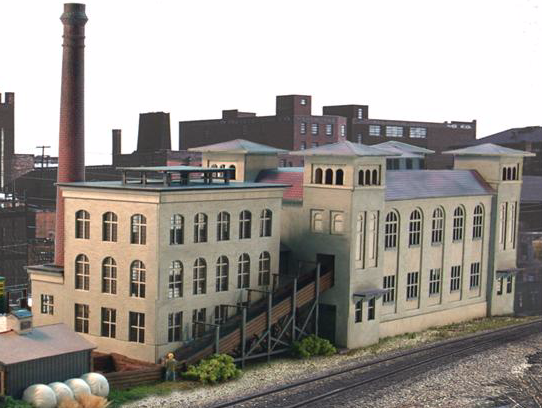Specific Item Information: The prototype that inspired this Quality Meat Packers kit was one of the first municipal abattoirs (meat packing plants) in North America. It was completed in 1916 next to the Grand Trunk Railway yard in Toronto, Canada and, based on the information obtained from the Architectural Index for Ontario, it is still in operation today. This Grand Trunk yard was absorbed into the Canadian National Railway System in the early 1900’s and still supports trains from this railway and several commuter lines. Photos from the John Boyd Collection of the National Archives of Canada were used in the design of this kit. A stock yard can be added to this model using the "Quality Meat Stock Yard (QME073)" kit which adds several barns, holding pens & loading ramps. These modular stock yard kits can be combined to create a larger stock yard operation. Beef cows, rolled hay bales and additional feeding troughs castings are available separately as part of our "Making A Scene" detail parts line. The completed Quality Meat Packers model covers an area of 12"L x 5"W x 5"H.
Road Name History:  A factory (previously manufactory) or manufacturing plant is an industrial site, usually consisting of buildings and machinery, or more commonly a complex having several buildings, where workers manufacture goods or operate machines processing one product into another.
A factory (previously manufactory) or manufacturing plant is an industrial site, usually consisting of buildings and machinery, or more commonly a complex having several buildings, where workers manufacture goods or operate machines processing one product into another.
Factories arose with the introduction of machinery during the Industrial Revolution when the capital and space requirements became too great for cottage industry or workshops. Early factories that contained small amounts of machinery, such as one or two spinning mules, and fewer than a dozen workers have been called "glorified workshops".
Most modern factories have large warehouses or warehouse-like facilities that contain heavy equipment used for assembly line production. Large factories tend to be located with access to multiple modes of transportation, with some having rail, highway and water loading and unloading facilities.
From Wikipedia

Factories arose with the introduction of machinery during the Industrial Revolution when the capital and space requirements became too great for cottage industry or workshops. Early factories that contained small amounts of machinery, such as one or two spinning mules, and fewer than a dozen workers have been called "glorified workshops".
Most modern factories have large warehouses or warehouse-like facilities that contain heavy equipment used for assembly line production. Large factories tend to be located with access to multiple modes of transportation, with some having rail, highway and water loading and unloading facilities.
From Wikipedia
Brand/Importer Information: The N Scale Architect was founded in 1991 by Russ Kaufman who has been active in model railroading since the early 1970s. Although many model railroaders received a Lionel Train as their first train set, Russ and his brother Bill were bitten by the model railroad bug in the form of an Aurora N-Scale set.
Russ started The N Scale Architect based on the encouragement of fellow modelers who thought that the plans he had drawn up for scratch building over the years might be enjoyed by others in kit form. The first kits featured detailed step-by-step instructions with hand drawn illustrations and plastic templates to be used for cutting the various pieces. This tradition of high quality instructions continues with the addition of "in-process" and color photos and, thanks to better computer aided programs, more detailed drawings. These templates have been replaced with laser-cut micro-plywood pieces along with the addition of many detailing castings which are now also available separately as part of their "Making A Scene" product line.
Russ started The N Scale Architect based on the encouragement of fellow modelers who thought that the plans he had drawn up for scratch building over the years might be enjoyed by others in kit form. The first kits featured detailed step-by-step instructions with hand drawn illustrations and plastic templates to be used for cutting the various pieces. This tradition of high quality instructions continues with the addition of "in-process" and color photos and, thanks to better computer aided programs, more detailed drawings. These templates have been replaced with laser-cut micro-plywood pieces along with the addition of many detailing castings which are now also available separately as part of their "Making A Scene" product line.
Item created by: CNW400 on 2021-01-14 15:41:25
If you see errors or missing data in this entry, please feel free to log in and edit it. Anyone with a Gmail account can log in instantly.
If you see errors or missing data in this entry, please feel free to log in and edit it. Anyone with a Gmail account can log in instantly.








